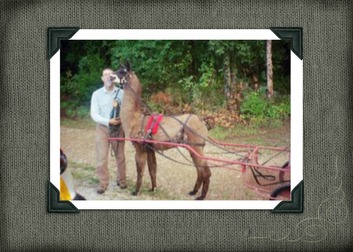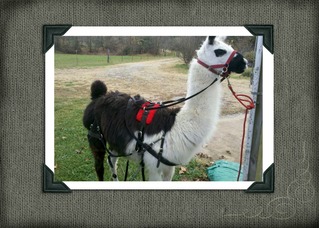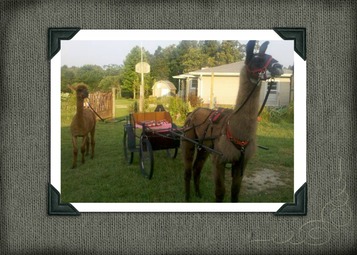Our story begins...
One day I decided that I wanted to teach llamas to pull a cart. Like most people I got on the internet and Googled "Driving Llamas". There is a lot of information out there about driving Llamas. As with most things on the internet you have to figure out what information to pay attention to and what not to. My grandfather had farmed with horses but that didn't help me much as he had retired before I was old enough to remember about it. I was raised on a farm and had been around saddle horses most of my life, so I thought "why not."
Milkyway . . .

I was in a local farm store in Buffalo, MO and saw an ad that had a young llama for sale. I called and went out to see him even though I knew nothing about llamas at the time. After I purchased him for $25.00, the man told me his name was "Milkyway." I had already made up my mind what I was going to name him before I saw him but, Milkyway just fit him so I left his name alone. When I told the man that I intended to teach him to pull a cart, he just laughed at me. "You think he's going to pull a cart?" he asked, and then continued to laugh.
Milkyway's mother had died when he was young. They had to bottle fed him so he had a lot contact with people. There was almost no problem putting a halter on him. With very little effort he learned to lead. I took him up and down the road (gravel road) and taught him to start and stop on command. We then worked on left and right turns on command followed by crossing ditches and going up hills.
Next, I bought a ground breaking harness which is nothing more than an adjustable strap that goes around the llama with two rings on the top for the lines to go through. I had a friend lead Milkyway and I took the driving lines. We went up and down the driveway using the commands that we had been working on with just the lead rope. We only worked for about fifteen minutes then stopped. The next day we did the same thing. The third day after starting we took off the lead rope. He did everything that he was supposed to do. Looking back, I probably could have had him pulling a cart in couple of weeks, but I didn't. We did a lot of walking and used the ground breaking harness and, finally, moved to the full harness.
Milkyway's mother had died when he was young. They had to bottle fed him so he had a lot contact with people. There was almost no problem putting a halter on him. With very little effort he learned to lead. I took him up and down the road (gravel road) and taught him to start and stop on command. We then worked on left and right turns on command followed by crossing ditches and going up hills.
Next, I bought a ground breaking harness which is nothing more than an adjustable strap that goes around the llama with two rings on the top for the lines to go through. I had a friend lead Milkyway and I took the driving lines. We went up and down the driveway using the commands that we had been working on with just the lead rope. We only worked for about fifteen minutes then stopped. The next day we did the same thing. The third day after starting we took off the lead rope. He did everything that he was supposed to do. Looking back, I probably could have had him pulling a cart in couple of weeks, but I didn't. We did a lot of walking and used the ground breaking harness and, finally, moved to the full harness.
Somewhere Along the Line I Bought Two Pony Carts. . .

I took them to "The Fab Shop" in Humansville, MO and the owner converted the shafts from pony carts to llama carts. Basically the space between the shafts had to be narrowed and the height raised to match the llamas height. Llamas have a longer stride than ponies so we had to make sure there was enough clearance between the llamas rear feet and the front of the cart. Luckily that part was OK. He did a GREAT job for a very reasonable price. It would have been very nice to go out and just buy a Llama cart but the prices were high and the shipping cost are up there too. My carts are not as nice to look at but have less than $200 total in both carts. They are both light enough for Milkyway to pull and they get the job done-- that is what matters!
Put the Cart Before the Llama . . .

After we put in probably ninety plus miles of ground breaking and having people laugh at us, I decided it was time to try the cart. First, we took the cart and pulled it in front of Milkyway while he was walking down the road. Then we pulled the cart along side of him and then, finally, behind him. This was done for about fifteen minutes the first day and less than five minutes the second day. Finally I hitched him to the cart. He was more than a little nervous. At first, I led him by the lead rope while he was pulling the cart. Turning around was the hardest and scariest part for him. We went up and down the road (about 1000 feet). Then, I took the reins while walking behind the cart and went up the road and back again. We did that a couple of times and then called it a day.
The next day, I did something that I probably shouldn't have done. After hitching him up, I stood behind the cart and walked behind it while he pulled the cart to the road in front of the house. We turned south and when he had gone thirty feet or so I stopped him. I got in the
cart and let my left leg hang out (just in case). I touched the driving lines to him and away he went. I stopped him after going only twenty feet. I made sure that I had the right line ready to pull him towards the woven fence just in case he decided not to stop; however, when I pulled on the reins, he stopped. I did that two more times.
The next day, I did something that I probably shouldn't have done. After hitching him up, I stood behind the cart and walked behind it while he pulled the cart to the road in front of the house. We turned south and when he had gone thirty feet or so I stopped him. I got in the
cart and let my left leg hang out (just in case). I touched the driving lines to him and away he went. I stopped him after going only twenty feet. I made sure that I had the right line ready to pull him towards the woven fence just in case he decided not to stop; however, when I pulled on the reins, he stopped. I did that two more times.
Spooky, Spooky ....
After getting Milkyway accustom to the cart, I started taking him on short trips up and down the road. He is always eager to but, but also very easy to spook. Llamas tend to sight see and don't always watch what is in front of them. They will see cattle, deer, or a car a half of a mile away but they don't see what's right in front of them. When they do look at what's closer to them they sometimes shy away or "spook." Just like a horse, it can catch you off guard and can be dangerous because the only thing holding you in that seat is gravity. I do try to position my feet (one in the front and one in the back of the floor) so I can help keep myself from being unseated. So far, I haven't been unseated, but there have been a few close calls.
You just never know what a llama will see or smell that you don't. Dogs are the worst! They are a natural enemy of the llama and they can smell dogs before they see them and you you won't have a clue what the llama is afraid of until the dog shows itself. Windmills in someones yard can be scary too, but you can see that coming and prepare for that. Usually when a llama goes past something that scares him the third time, he will be over whatever it is that scares him.
You just never know what a llama will see or smell that you don't. Dogs are the worst! They are a natural enemy of the llama and they can smell dogs before they see them and you you won't have a clue what the llama is afraid of until the dog shows itself. Windmills in someones yard can be scary too, but you can see that coming and prepare for that. Usually when a llama goes past something that scares him the third time, he will be over whatever it is that scares him.
Enter a Little Lady . . .

While Milkyway was doing such a great job driving, I purchased Dolly Llama. She was priced $35 at a local sale barn in Bolivar, MO. She was only about six months old and very scared. When we tried to take her out of the pen at the sale barn she laid down. We had to lift her on the trailer and then off of it when we got her home. Long story short, she was green broke to the harness as of Feb '09.
On some websites they say not to use females for "carting;" some say it is OK to use females; and others don't have a position. In her case, Dolly did really well with one exception: she was very laid back. She did what she was asked to do in the harness but walked very slowly. I have since tied her to the cart when Milkyway and I were out in town. The first time she held him back and he had to pull her along and he didn't like that. Eventually, she kept up. I was hoping that she would develop the desire to pull like he has, but if she didn't, that would have been OK too because she was so young. I planned to put her to the cart in April when she would turn two years old. That was really too young as well, but if I didn't try to do too much with her she would be OK. I had a cart that was supposed to be used behind a lawn tractor that had since been modified for her to use in the beginning of her training. It was very light and would be good practice for her.
It was common to have people stop us to ask questions and/or take our pictures. Dolly Llama was becoming quite the starlet around these parts.
On some websites they say not to use females for "carting;" some say it is OK to use females; and others don't have a position. In her case, Dolly did really well with one exception: she was very laid back. She did what she was asked to do in the harness but walked very slowly. I have since tied her to the cart when Milkyway and I were out in town. The first time she held him back and he had to pull her along and he didn't like that. Eventually, she kept up. I was hoping that she would develop the desire to pull like he has, but if she didn't, that would have been OK too because she was so young. I planned to put her to the cart in April when she would turn two years old. That was really too young as well, but if I didn't try to do too much with her she would be OK. I had a cart that was supposed to be used behind a lawn tractor that had since been modified for her to use in the beginning of her training. It was very light and would be good practice for her.
It was common to have people stop us to ask questions and/or take our pictures. Dolly Llama was becoming quite the starlet around these parts.
Ferdinand and He's No Bull . . .

Ferdinand was living in Humansville, MO on a small farm owned by people who had bought him to be a guard llama for their goats. I saw their ad on Craigslist and called. When I got there it was about nine o'clock at night and in the middle of a thunderstorm. He was very young, scared, and wild as a mountain goat. I paid sixty dollars for him even though I didn't think he was worth it. I figured I would find him a good home on a goat or sheep farm that had other llamas. The next morning when we went to get him, we decided that he was at the most six months old. He was probably closer to four or five months old. We had to trap him in the barn to catch him. Even then he wasn't easy to catch. He tried to go through an open window. His fiber was so bad that you couldn't touch him. He had briers and anything else that could make him dangerous to touch.

